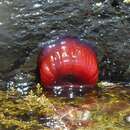en
names in breadcrumbs


Sea Anemones are benthic sessile polyps without a skeleton. They are solitary; with the exception of one colonial species, Cereus herpetodes, which is known from Chile. The proximal end of the sea anemone is either rounded, in which case the species is buried in soft substrate, or forms a more or less well developed flat pedal disc, which it uses to attach to hard substrate. The column is smooth or provided with hard structures such as verrucae, tenaculi, tubercles, vesicles, marginal spherules, marginal pseudospherules, or marginal projections.
The oral disc (at the distal end) is usually circular; in some cases it can be drawn out into lobes (eg: Anthologa achates). The tentacles are generally simple, hollow, and usually arranged in hexamerously alternating cycles. They arise from the margin and/or the oral disc, and nearly never possess spherical tips. Some species possess special fighting tenacles that can be everted or retracted; they bear large amounts of special cnidae used for defense. Colour and markings of the animals are highly variable.
These sessile Cnidaria occur throughout the world oceans in deep and shallow water from the equator to the poles. They have extremely pliable bodies that can undergo drastic, though slow, shape changes, thanks to the thick mesoglea (gel) within their body wall. The properties of the mesoglea allow sea anemones to resist sudden forces, like a strong ocean current, but to adapt their shape deliberately if needed to open for feeding or to become compact for protection. (Vogel, 2003)
Sea Anemones may be best known for their symbiotic relationship with clownfishes or anemonefishes, from the Genus Amphiprion and the Genus Premnas. Only ten of the >1000 species of Actiniaria are known to associate with clownfish, and all ten of them are shallow-water dwellers, because they all have another symbiotic relationship in common- they all host single-celled algae within their tissues. These algae produce sugar through photosynthesis (which is why this partnership must live in shallow water with abundant sunlight), and share it with their sea anemone host in exchange for shelter. This kind of relationship is quite common in Cnidaria. Reef forming corals also host algae this way. (Fautin and Allen, 1992)
The relationship between sea anemones and clownfish is more unusual. Sea anemones, like corals and other Cnidaria, have stinging cells in their tentacles, but clownfish living with them are not stung. How they manage this is not well understood, but it appears to be related to a mucus coating their skin. Researchers disagree over whether this is produced by the fish, or produced by the anemone and gradually picked up by the fish. A clownfish does take some time to adapt to an anemone host at first, touching and then retreating from the tentacles until gradually it settles among them unharmed.(Fautin and Allen, 1992)
The benefit to the clownfish is clear. Predators will not pursue them among their host's stinging tentacles, and in nature clownfish are rarely seen far from a host anemone. In some cases, the anemone also benefits. When clownfish were removed from their anemone host Entacmaea quadricolor in Papua New Guinea, within a single day, the anemones had been decimated, apparently by butterfly fish, which were still hunting for leftover scraps when researchers returned. (These fish are also protected from the stinging cells of Cnidaria, like the corals they usually feed on, and evidently, also this sea anemone.) Other species of sea anemone host clownfish some of the time but thrive without them also, and may not benefit from the relationship.(Fautin and Allen, 1992)
Small crustaceans, including crabs and shrimp sometimes also associate closely with sea anemones. These small animals have proven to be nimble and elusive, so researchers don't yet know very much about these relationships.(Fautin and Allen, 1992)